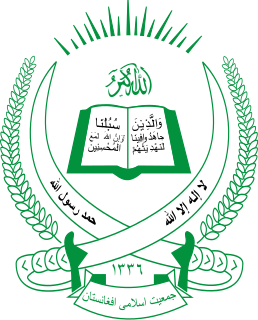 W
WThe Afghan mujahideen were the various armed Islamist rebel groups that fought together against both the Soviet Union and the government of the Democratic Republic of Afghanistan during the Soviet–Afghan War and the subsequent First Afghan Civil War. The term mujahideen is used in a religious context by Muslims to refer those engaged in a struggle of any nature for the sake of Islam, commonly referred to as jihad (جهاد). The Afghan mujahideen consisted of numerous groups that differed from each other across ethnic and/or ideological lines, but were united by their anti-communist and pro-Islamic goals. The union was also widely referred to by their Western backers as the Afghan resistance, while Western press often referred to them as Muslim rebels, guerrillas, or "Mountain Men". They were popularly referred to by Soviet troops as dukhi due to their guerrilla tactics; Afghan civilians often referred to them as the tanzim, while the Afghan government called them dushman, a term also employed by the Soviets.
 W
WHezb-e Islami Khalis is an Afghan political movement under Maulawi Khalis, who separated from Gulbuddin Hekmatyar's Hezb-e Islami and formed his own resistance group in 1979. The two parties were distinguished as Hezb-e Islami Gulbuddin and Hezb-e Islami Khalis, after the names of their respective leaders.
 W
WThe Hezb-e-Islami Gulbuddin, also referred to as Hezb-e-Islami or Hezb-i-Islami Afghanistan (HIA), is an Afghan political party and former militia, founded and led by Gulbuddin Hekmatyar.
 W
WHezb-e-Islami, meaning Islamic Party was an Islamist organization that was commonly known for fighting the Communist Government of Afghanistan and their close ally the Soviet Union. Founded and led by Gulbuddin Hekmatyar, it was established in Afghanistan in 1975. It grew out of the Muslim Youth organization, an Islamist organization founded in Kabul by students and teachers at Kabul University in 1969 to combat communism in Afghanistan. Its membership was drawn from ethnic Pashtuns, and its ideology from the Muslim Brotherhood and Abul Ala Maududi's Jamaat-e-Islami. Another source describes it as having splintered away from Burhanuddin Rabbani's original Islamist party, Jamiat-e Islami, in 1976, after Hekmatyar found that group too moderate and willing to compromise with others.
 W
WThe Islamic Dawah Organization of Afghanistan is a political party in Afghanistan led by Abdul Rasul Sayyaf. Founded in the early 1980s as the Islamic Union for the Liberation of Afghanistan, it was originally an attempt to bring unity amongst Islamist opposition forces in Afghanistan. However, the creation of the new umbrella organization effectively created a split and the organization became a political party of its own. The organization was part of the 'Peshawar Seven', the coalition of mujahedin forces supported by the United States, Pakistan and various Arab states of the Persian Gulf in the war against the PDPA government, Soviet forces and Ba'athist Iraq. Through the financial aid received from Saudi sources, the organization was able to attract a considerable military following. Arab volunteers fought in the militia forces of the organisation.
 W
WJamayat-E-Islami, sometimes shortened to Jamiat, is a political party in Afghanistan. The oldest Muslim political party in Afghanistan, it was originally formed as a student political society at Kabul University. The majority of the party are ethnic Tajiks of northern and western Afghanistan. It has a communitarian ideology based on Islamic law. During the Soviet–Afghan War and the following Afghan Civil War against the communist government, Jamiat-e Islami was one of the most powerful of the Afghan mujahideen groups. Burhanuddin Rabbani led the party from 1968 to 2011, and served as President of the Islamic State of Afghanistan from 1992 to 2001, on exile from 1996.
 W
WNational Islamic Front of Afghanistan is a political party in Afghanistan. It has been led, since its founding, by members of a prominent Sufi family, the Gailani. It is primarily a Pashtun party, followers of the Sufi holy man Pir Sayed Ahmed Gailani have a reputation for moderate thought and the traditional mystical and introspective religious currents that characterize Sufism in that sect.
 W
WOperation Cyclone was the code name for the United States Central Intelligence Agency (CIA) program to arm and finance the Afghan mujahideen in Afghanistan from 1979 to 1989, prior to and during the military intervention by the USSR in support of the Democratic Republic of Afghanistan. The mujahideen were also supported by Britain's MI6, who conducted separate covert actions. The program leaned heavily towards supporting militant Islamic groups, including groups with jihadist ties, that were favored by the regime of Muhammad Zia-ul-Haq in neighboring Pakistan, rather than other, less ideological Afghan resistance groups that had also been fighting the Soviet-oriented Democratic Republic of Afghanistan regime since before the Soviet intervention.
 W
WThe Shura-e Nazar was created by Ahmad Shah Massoud in 1984 at the northern provinces of Takhar, Badakhshan, Balkh and Kunduz, during the Soviet-Afghan War. It comprised and united about 130 resistance commanders from 12 northern, eastern and central regions of Afghanistan. Though operating autonomously, Shura-e Nazar was technically an offshoot of Rabbani's Jamiat-e Islami and hence operated within the framework of the Peshawar Seven against the Soviet-supported Democratic Republic of Afghanistan.